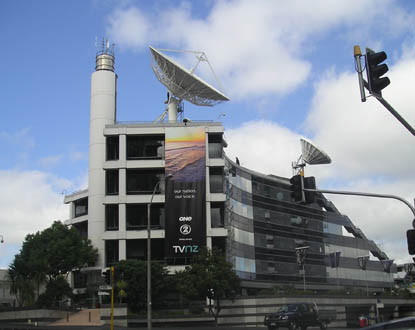
Paul Norris examines the changing structure of New Zealand's broadcasting industry.
OPINION: Our media landscape is changing for the worse. Until recently, Television New Zealand had two digital channels, one aimed at children and families and the other a news and factual channel. Both were free-to-air and without advertisements.
They were largely funded by the government in a deal with Labour struck five years ago. But the money is soon to run out and the government has announced no further funding will be available.
TVNZ has at least been proactive in dealing with the situation. TVNZ6 has been rebranded as U, a youth channel targeting 15 to 24-year-olds, and gone commercial. Much of the children's programming that was on TVNZ6 (it was 12 hours a day) will go to a subscription channel soon to start up on Sky.
A mere two hours a day has transferred to TVNZ7, which has enough funding to last until mid-2012. After that it will disappear from our screens unless a solution is found.
Why should we care about this situation? First, because viewers will be disadvantaged by the loss of these channels.
Already there have been complaints from parents who found value in the range and quality of children's programmes on TVNZ6 and who are unwilling to have to subscribe to Sky to get them. Despite little promotion, these channels had built a loyal audience, 1.9 million watched over a four-week period, roughly the same as the numbers for Māori TV - also funded largely by government.
Quality programmes
TVNZ7 has arguably the most serious hour-long national news bulletin in the schedules, as well as news on the hour and many quality documentaries and factual programmes. These include New Zealand programmes such as Media 7, Backbenches, The Court Report, The Good Word and Hindsight.
The point about these programmes is that they, or programmes like them, cannot be found elsewhere. Most other channels are strictly commercial, screening programmes that are driven by the need to bring in the advertising dollar.
TVNZ6 and TVNZ7 were providing a genuine public service, in other words they were the last bastion of public broadcasting on New Zealand television, with the notable exception of Māori Television.
So the key question for us, as viewers and citizens, is how can we tolerate a situation where New Zealand ends up as the only country in the Western world that has no mainstream public broadcaster for television?
Is this the best we can do - that our entire diet on mainstream television is driven by commercial imperatives, where we are treated as consumers to be sold to rather than as citizens requiring information and cultural nourishment in order to participate adequately in our society?
Make no mistake - the public may own TVNZ, but it is a public broadcaster no more. This government has stripped it of its charter and made it quite clear it is a fully commercial broadcaster whose mission is to deliver profits and a healthy dividend to the Treasury.
It is primed for sale to the highest bidder, if the government were bold enough to take this unprecedented step.
NZ On Air
Some government ministers, such as Minister of Broadcasting Dr Jonathan Coleman are fond of claiming that we do still have public broadcasting, in that NZ On Air, as the funding agency, is our version of public broadcasting.
But this is a very thin view of public broadcasting. NZ On Air may do a good job of allocating funds for New Zealand programmes, but it is not a broadcaster. The broadcasters call the shots, cherry-picking the more commercial proposals.
Ideas that are less commercial or minority interest will either not be accepted or consigned to the nether regions of the schedule. The harsh reality is that if TVNZ7 is to survive in any form, then some alternative funding will have to be found.
How about a levy on the net profits of commercial broadcasters above a certain figure, say $30 million? The rationale for this approach is that if there are no requirements on the commercial broadcasters for any kind of public broadcasting - programmes driven by the public interest - then they should pay for this privilege by contributing to the overall media landscape within which a measure of public broadcasting can be found.
It is acknowledged that the only commercial broadcaster who would be affected by such a levy would be Sky. No other broadcaster is making a sufficient level of profit. It could be said there is an element of rough justice about this proposal.
Sky has benefited greatly from the almost total absence of regulation in broadcasting. It is now clearly the dominant broadcaster in New Zealand, with almost 50 percent of households as subscribers. How telling that it recently secured the rights to netball by outbidding TVNZ, offering three times the state broadcaster's figure.
It was allowed to buy the free-to-air network Prime, enabling it to compete strongly with TVNZ and TV3 for rights to drama and entertainment programmes. There's a relentless momentum towards increasing dominance.
No rules
Unlike many other countries, there are no rules as to what free-to-air channels Sky must carry, or what it should pay for them.
Sky manipulated TVNZ into deals whereby it carries TV One and TV2 for no payment, likewise TVNZ6 (before the change to U) and TVNZ7. Sky has also persuaded TVNZ to give it the Heartland channel exclusively, and the forthcoming Kidzone channel. There would seem to be a strong case that these channels, containing much content that has been partly publicly funded, should not be locked beyond the pay wall.
Some would say our media landscape is now fundamentally damaged, given the dominance of Sky and the gross imbalance between commercial and public interests. Some would argue that we need more urgently than ever the review of broadcasting regulation cast aside in cavalier fashion by this government.
At least a levy to save TVNZ7 would be a start.
Paul Norris is head of the New Zealand Broadcasting School at the Christchurch Polytechnic. This article was first published by the New Zealand Herald Online and has been republished here with the permission of the author.
61 academics condemn govt broadcasting crisis
Media academic petition govt over TVNZ7
Full text of petition



